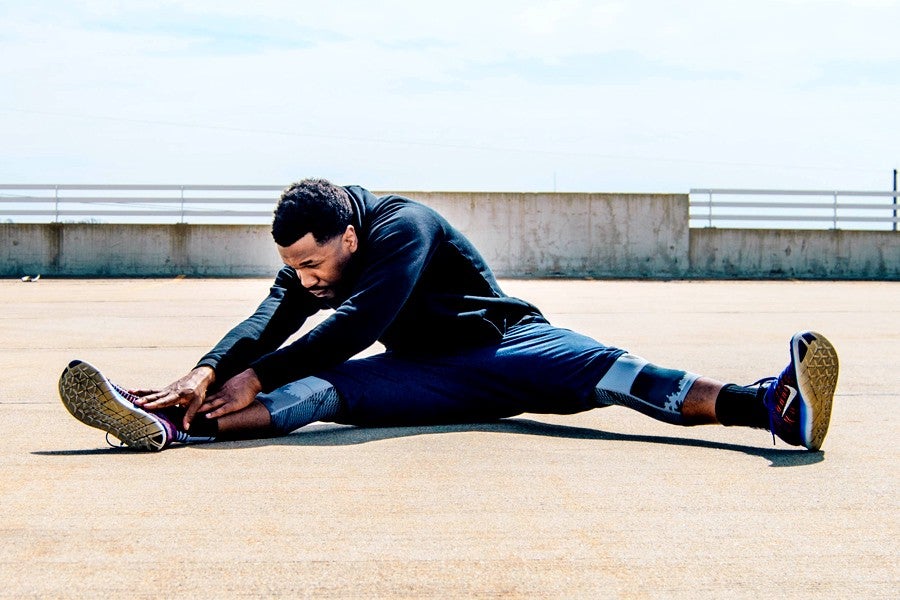How we exercise — and who we choose to do it with — is a matter of personal preference. One gym addict might prefer sweating it out alone, shutting out the world and everyone in it while pounding the treadmill full-tilt to AC/DC’s “For Those About to Rock (We Salute You).” Another, more casual gym-goer might need a gym buddy to keep them accountable — one who encourages them to finish those final few reps with positive comments. And of course, there are the CrossFitters and SoulCyclists of the world, who swear to the God of Swole that nothing beats working out in a class setting.
The truth is, however, solo exercise sessions, partner workouts and group fitness classes all have their own unique benefits. To help figure out which works best for you, we discussed the individual merits of each with Jonathan Jordan, award-winning trainer at Equinox Fitness.
The Benefits of Exercising Alone
In addition to being extremely flexible — you can work out where you want, when you want and at whatever pace you want — Jordan says working out alone primarily allows you to focus on your body’s individual needs. “Working out alone is a great way to completely focus on yourself,” he explains. “You can follow a program that’s 100 percent customized to your needs and your body.” That way, you don’t have to spend half an hour watching your partner do squats while you want to work on your chest.
Science agrees: Research performed by Santa Clara University psychologist Thomas Plante found that those who exercise alone report feeling calmer and less stressed than those with workout buddies. “The bottom line here,” Plante told U.S. News, “is that if you want to have a low stress, contemplative, relaxed experience, then you want to exercise alone. But if you want to have an energizing, engaged and socially uplifting experience, exercise with others.”
Of course, there’s one downside to going solo: “It can be lonely, and those who struggle with consistency can easily convince themselves to skip an exercise if they’re having trouble,” Jordan says.
Simply put, working out alone requires a decent amount of self-motivation, and if you suck at that, you’re going to let those new compression shorts go to waste.
The Benefits of Exercising with a Buddy
“Gym buddies are great for adding accountability and making sure you stick to your plans,” Jordan emphasizes. “They also can be a great source of ideas and new exercises, and can help you push beyond your comfort zone.”
But choosing the right buddy can be the difference between a great workout and a total fail: A 2012 study found that burning more calories is easier when working out with someone you perceive as better (or stronger), noting that the key to motivation may be feeling inadequate. More recently, a 2016 study found that people with a workout buddy — especially one who’s emotionally supportive — exercise more than those who go at it alone. Basically, you want to pick someone who (1) knows what they’re doing; and (2) supports what you’re doing.
According to Jordan, picking the wrong partner can turn your workouts into more of a “social hour” than an exercise routine, which presumably isn’t what you’re after. “Workout buddies should write and stick to a program, rather than freestyling it,” he says. “Also, if your gym buddy is in a different place physically (maybe they have an injury), the workout could be ineffective for one of you, so make sure they have a similar baseline and goals.”
The Benefits of Exercising with a Class
Above all, Jordan says group exercise classes provide consistency, which is vital if you’re hoping to achieve your fitness goals. “You can be sure that the instructor will be there each week at the same time with a plan (that is, if they’re a good instructor),” he emphasizes. “As a personal trainer and a group fitness instructor, I have a specific program for my students that builds week after week, but also allows for newcomers. My students who consistently come to class have better form, and they get stronger and leaner. It’s amazing to watch.”
A recent study published in The Journal of the American Osteopathic Association also found that exercising in a group makes people feel better about their physical and emotional well-being, compared to those who exercise by themselves. “The communal benefits of coming together with friends and colleagues, and doing something difficult while encouraging one another, pays dividends beyond exercising alone,” lead researched Dayna Yorks said in a statement. “The findings support the concept of a mental, physical and emotional approach to health that is necessary for student doctors and physicians.”
But of course, finding the right instructor is vital. “I suggest finding instructors who are full-time fitness professionals, rather than fitness enthusiasts who just teach here and there,” Jordan says. “Full-time trainers have training in exercise science, anatomy and kinesiology, not to mention nutrition and regeneration. That kind of training can be the difference between a workout program and a fitness program.”
So there you have it: All the pros and cons to consider when figuring out what’s right for you. And in a move that’s a little uncharacteristic for us, let’s end on a note of positivity: Remember that, at the end of the day, so long as you’re spending any time in the gym, you’re doing something right.

